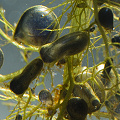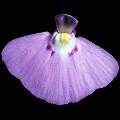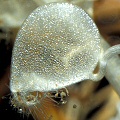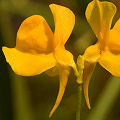Q: Utricularia: the bladderworts
A: Welcome to Utricularia, the largest genus of carnivorous plants,
with more than 220 species that
occur throughout the world. The Latin genus name refers to the fact that the plant is festooned with utricles,
or little baglike bladders, 1-several mm in size. Obviously, they also have given the plant its common name.
These little bladders are carnivorous traps like none other, and they are guaranteed to astonish!
Utricularia have been known about for a long time; in 1753 Linnaeus mentioned
seven species (U. bifida, U. caerulea,
U. foliosa, U. gibba,
U. minor, U. subulata, and U. vulgaris).
However, the function of its strange bladders, that are produced underground or underwater,
were long misunderstood and thought perhaps to be flotation devices (the most flamboyant species known were aquatic).
But in 1876, a scientist named Mary Treat realized that the bladders were actually suction traps; afterwards Darwin and Lloyd
did more work on the genus indicating carnivory. A crucial marker for our understanding of the genus was the publication by
Peter Taylor of his great monograph on the genus. A marvelous combination of technical expertise, dedication, and love, this
work is an amazing thing.
In Taylor's monograph, he divided the genus into two subgenera and 35 sections. More recent work suggested that the best way to
decompose the genus is into three subgenera and 33 sections. How to best handle the genus subdivision is anything but
transparent, and I am sure that many will not agree with the approach I have taken. If you disagree, please prove me otherwise
in the published literature! I'll be happy to incorporate improvements based upon citable research.
Utricularia have invaded just about every imaginable habitat where plant carnivory is an
advantage. They are found on every continent except for Antarctica. In the USA they can be found in every state; in Canada
they are in every province; in Australia they are so common they are eating the children. (OK, strike that last part.)
Species have pioneered many habitats, including waterlogged soils, lakes, streams, the surfaces and crevices in trees and
bromeliads, and seasonally-moist deserts! The only habitat they have not exploited is strongly brackish to
marine environments. (Although Utricularia benjaminiana can survive in some moderately
brackish waters.)
Utricularia flowers are usually very small, but they make up for their small size by having a wild
and varied display of colours and form. There are many species, so those who study them must use careful botanical
terminology to describe the flowers. To identify species, you must learn a number of
carefully defined botanical terms.
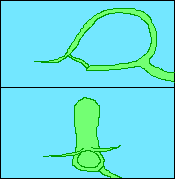
U. macrorhiza
The above ground parts of terrestrial species are often small and inconspicuous; the leaves may be grasslike, oval, or
strap-shaped. Meanwhile, the carnivorous bladders are the most complicated and devious in
all the carnivorous plants, and is surely one of the wonders of the botanical world!
The carnivorous action happens underwater or underground in the water-soaked medium. The bladder sets itself by pumping fluid out
of its interior, via special bifid and quadrifid glands. As a result, the water pressure inside the bladder is lower than the
surrounding water. The bladder has trap door, but it is firmly set closed by a combination of a threshold ridge at the bladder
entrance and mucous as an additional sealant. Small organisms find their way to the trap entrance (it is unknown whether they
just wander up to the trap, or are somehow attracted to the trap door).
Either by bumping into the door, or perhaps by touching the little
hairlike organs protructing out of the trap door, they trigger the bladder. Either they simply lever the door ajar (perhaps with
the mechanical advantage of the door-hairs), or the door may weaken slightly through some active process (perhaps similar to
the changes in turgor pressure that makes Mimosa plants droop, or processes that occur in
Dionaea?). Since the pressure in the trap is low, water rushes into the trap, carrying the
animal with it. The prey has no chance to protest since it is drawn into the trap in
as little as 1/30 of a second. The trapdoor swings closed again, sealing the creature inside.
The bladder releases digestive
enzymes and digests the creature. Depending upon the size of the prey, it takes a few hours to a few days to consume
the prey. Very large prey, such as worms, that are not completely trapped may be digested over long periods of time as
the bladder digests the prey-parts in the trap, and as it slowly draws the rest of the prey into the trap as it
dissolves, all while still alive. How horrible is that?!
In another direction, it might be that some species such as Utricularia multifida are lobster pot traps...
Page citations: Darwin, C. 1875; Lloyd, F.E. 1942;
Müller, K., and Borsch, T. 2005; Reifenrath, K. et al. 2006; Rice, B.A. 2006a;
Schlauer, J. 2002; Taylor, P. 1989; personal observations.
